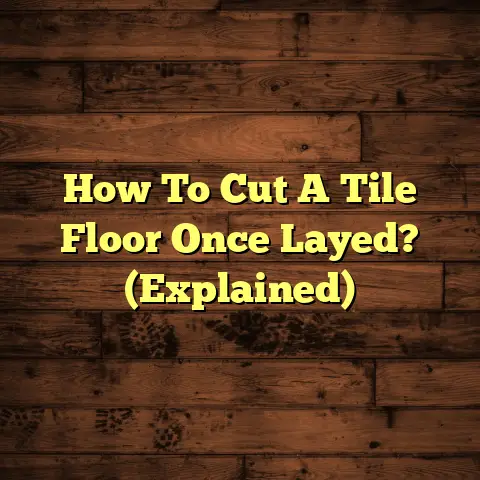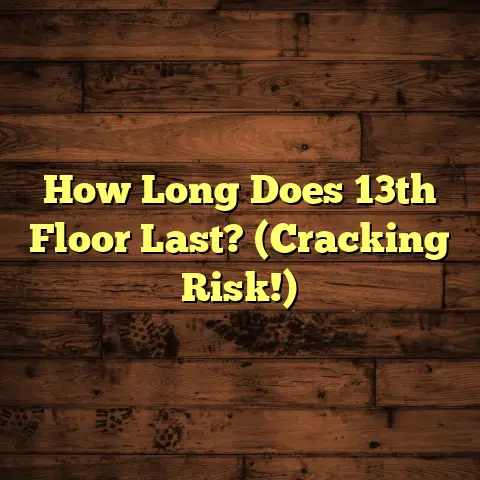Fix Sinking Bathroom Floor Now? (1 Call Could Save It!)
Ever walked into your bathroom and felt like the floor wasn’t quite… right? Maybe a little too soft, or a tile that’s definitely lower than it used to be?
That sinking feeling in your stomach? It might be mirroring your bathroom floor!
But don’t panic! A sinking bathroom floor isn’t just a cosmetic issue. It’s a sign that something deeper is going on.
The good news? Catching it early can save you a ton of headaches (and money!) down the road. That’s where a quick call to a pro can be a lifesaver.
I’m talking about preventing major structural damage, avoiding costly repairs, and ensuring your bathroom is safe and sound.
Trust me, as a flooring contractor who’s seen it all, from minor dips to full-blown collapses, that one call can make all the difference.
Let’s dive in, shall we?
Section 1: Understanding the Problem
of a Sinking Bathroom Floor
Definition and Signs of a Sinking
Bathroom Floor
So, what exactly is a sinking bathroom floor?
Simply put, it’s when a portion of your bathroom floor is lower than it should be, or feels unstable underfoot. It’s a sign that the subfloor underneath is losing its structural integrity.
Think of it like this: your floor is like a bridge. The tiles are the road, and the subfloor is the support structure.
If that support starts to weaken, the road starts to sag. I’ve seen it happen countless times!
Here are some telltale signs to watch out for:
-
Soft Spots: Step on a certain area and it feels spongy or gives way slightly? That’s a big red flag.
-
Uneven Tiles: Notice tiles are cracked, loose, or sitting at different heights? This indicates the subfloor is shifting.
-
Visible Gaps: Are there gaps between the floor and the baseboards, walls, or around the toilet? That means the floor is pulling away.
-
Creaking or Groaning: Does the floor make unusual noises when you walk on it? That could be the sound of the subfloor struggling.
-
Musty Odor: A persistent musty smell, especially near the floor, could indicate water damage and mold growth underneath.
-
Visible Water Damage: Stains on the ceiling below the bathroom or around the base of the toilet are signs of a leak that could be affecting the floor.
Causes of a Sinking Floor
Alright, so you’ve spotted some of these signs. Now, what’s causing your bathroom floor to sink?
Unfortunately, there’s no single answer, but here are some of the most common culprits I’ve encountered:
-
Water Damage: This is the number one offender! Bathrooms are wet environments, and even small leaks from showers, toilets, or sinks can wreak havoc over time.
Water seeps into the subfloor (usually plywood or OSB), causing it to rot and weaken. I can’t stress enough how important it is to address even minor leaks promptly.
-
Plumbing Leaks: Hidden leaks under the sink, behind the toilet, or in the pipes within the floor can go unnoticed for a long time, slowly saturating the subfloor.
These are often the trickiest to find, requiring specialized equipment like moisture meters and even thermal imaging cameras.
-
Foundation Issues: In some cases, a sinking bathroom floor can be a symptom of a larger foundation problem.
If your house is settling unevenly, it can put stress on the floor joists and subfloor, leading to sagging.
-
Soil Erosion: If your bathroom is on a slab foundation, soil erosion around the perimeter of your home can create voids underneath the slab, causing it to sink in certain areas.
-
Improper Installation: Sometimes, the problem starts right from the beginning. If the floor wasn’t installed correctly in the first place, with adequate support and moisture protection, it’s more likely to fail over time.
-
Poor Ventilation: Bathrooms need proper ventilation to remove excess moisture. If your bathroom fan isn’t working properly or you don’t use it regularly, moisture can build up and contribute to water damage.
The Importance of Addressing
the Issue Promptly
Okay, so you know what a sinking bathroom floor is, and you have an idea of what might be causing it.
But why is it so important to fix it ASAP?
Well, ignoring a sinking floor is like ignoring a toothache. It might start as a minor annoyance, but it will eventually become a major pain (and a much more expensive problem to fix!).
Here’s what you’re risking by putting it off:
-
Increased Repair Costs: The longer you wait, the more extensive the damage becomes. What starts as a simple subfloor repair can turn into a full-blown structural overhaul.
I’ve seen cases where homeowners delayed repairs for so long that they ended up having to replace entire sections of the floor joists and even the foundation!
-
Mold Growth: Water damage creates the perfect breeding ground for mold, which can cause serious health problems, especially for people with allergies or respiratory issues.
Mold remediation can be a costly and disruptive process, so it’s best to prevent it in the first place.
-
Safety Hazards: A sinking floor can become a tripping hazard, especially for elderly people or young children. Loose tiles can also be sharp and cause cuts.
In extreme cases, the floor can even collapse, leading to serious injuries.
-
Damage to Surrounding Areas: Water damage from a sinking floor can spread to adjacent walls, ceilings, and even other rooms in your house.
This can lead to peeling paint, warped drywall, and even structural damage to the rest of your home.
-
Reduced Home Value: A sinking bathroom floor is a major turnoff for potential buyers and can significantly reduce the value of your home.
I’ve seen homes sell for tens of thousands of dollars less than they would have otherwise, simply because of unresolved water damage issues.
Section 2: The Consequences of a
Sinking Bathroom Floor
Impact on Home Value
Let’s talk about the cold, hard truth: a sinking bathroom floor is a major ding on your home’s value.
Think about it from a buyer’s perspective. They walk into a bathroom and see cracked tiles, soft spots, or obvious signs of water damage.
What’s the first thing that comes to mind?
“Expensive repairs!” “Hidden problems!” “Headache!”
According to a 2023 report by the National Association of Realtors, “structural problems” are among the top factors that deter potential buyers.
A sinking floor definitely falls into that category.
Here’s how it can impact your home’s value:
-
Lower Appraisal: Appraisers are trained to identify and assess structural issues. A sinking floor will definitely be noted in the appraisal report, and it will likely result in a lower valuation.
-
Reduced Buyer Interest: As I mentioned earlier, buyers are often scared off by visible signs of water damage or structural problems.
They may simply move on to the next listing, or they may submit a much lower offer to compensate for the cost of repairs.
-
Negotiating Leverage: Even if a buyer is interested in your home, they’ll likely use the sinking floor as a bargaining chip to negotiate a lower price.
They may ask you to reduce the price by the estimated cost of repairs, or they may request that you fix the problem before closing.
-
Difficulty Selling: In some cases, a sinking bathroom floor can make it difficult to sell your home at all.
Buyers may be unwilling to take on the risk of unknown problems, especially if they’re first-time homebuyers or on a tight budget.
Health Risks
Beyond the financial implications, a sinking bathroom floor can also pose serious health risks.
The primary culprit here is mold. Mold thrives in damp, dark environments, and a water-damaged subfloor is the perfect breeding ground.
Here are some of the health problems associated with mold exposure:
-
Respiratory Issues: Mold can irritate the lungs and airways, leading to coughing, wheezing, shortness of breath, and other respiratory problems.
People with asthma or other respiratory conditions are particularly vulnerable.
-
Allergies: Mold can trigger allergic reactions, causing symptoms such as sneezing, runny nose, itchy eyes, and skin rashes.
-
Skin Irritation: Direct contact with mold can cause skin irritation, including redness, itching, and blisters.
-
Eye Irritation: Mold spores can irritate the eyes, causing redness, itching, and blurred vision.
-
Headaches: Mold exposure can cause headaches, fatigue, and other flu-like symptoms.
-
Neurological Problems: In rare cases, exposure to certain types of mold can cause neurological problems, such as memory loss, difficulty concentrating, and mood changes.
According to the Environmental Protection Agency (EPA), mold can affect anyone, but some people are more sensitive to it than others.
These include:
- Infants and children
- Pregnant women
- Elderly people
- People with respiratory conditions
- People with weakened immune systems
If you suspect you have mold in your bathroom, it’s important to have it tested and removed by a qualified professional.
Safety Concerns
Finally, let’s not forget about the immediate safety concerns posed by a sinking bathroom floor.
A compromised floor can create a number of hazards, including:
-
Slips and Falls: Uneven surfaces, loose tiles, and soft spots can all increase the risk of slips and falls, especially in a wet environment like a bathroom.
According to the Centers for Disease Control and Prevention (CDC), falls are a leading cause of injury and death for older adults.
-
Tripping Hazards: Cracked or missing tiles can create tripping hazards, especially for people with limited mobility.
-
Sharp Edges: Broken tiles can have sharp edges that can cause cuts and scrapes.
-
Collapse: In extreme cases, a severely damaged floor can collapse, leading to serious injuries.
I’ve personally seen a case where a homeowner stepped through a weakened bathroom floor and broke their leg!
It’s simply not worth the risk to ignore a sinking bathroom floor.
Section 3: The Solution – Contacting
Professionals
The Role of Experts
Alright, so you’re convinced that you need to fix your sinking bathroom floor. But where do you start?
The best thing you can do is call in the experts.
I’m not just saying that because I’m a flooring contractor! I truly believe that hiring qualified professionals is the best way to ensure the job is done right, safely, and efficiently.
Here’s why:
-
Accurate Assessment: Professionals have the experience and training to accurately assess the extent of the damage and identify the underlying cause of the problem.
They’ll use specialized tools like moisture meters, infrared cameras, and levels to get a clear picture of what’s going on.
-
Proper Repair Techniques: Repairing a sinking bathroom floor is not a DIY project. It requires specialized knowledge of building codes, structural engineering, and waterproofing techniques.
Professionals know how to properly support the floor joists, replace damaged subfloor, and install new flooring materials to prevent future problems.
-
Safety: Working with power tools, removing mold, and dealing with structural issues can be dangerous. Professionals have the training and equipment to do the job safely, protecting themselves and your family.
-
Warranty: Most professional contractors offer warranties on their work, giving you peace of mind knowing that you’re protected if something goes wrong.
-
Insurance: Reputable contractors carry liability insurance, which protects you in case of accidents or damage to your property.
What to Expect During a Professional
Evaluation
So, what happens when you call a professional to evaluate your sinking bathroom floor?
Here’s a general overview of the assessment process:
-
Initial Consultation: The contractor will ask you questions about the problem, such as when you first noticed it, what signs you’ve observed, and any previous repairs you’ve had done.
-
Visual Inspection: The contractor will visually inspect the bathroom floor, looking for signs of water damage, cracks, unevenness, and other issues.
-
Moisture Testing: The contractor will use a moisture meter to measure the moisture content of the subfloor and surrounding areas.
This helps them determine the extent of the water damage and identify any hidden leaks.
-
Leveling: The contractor will use a level to determine how much the floor has sunk and to identify any uneven spots.
-
Subfloor Inspection: The contractor may need to remove a section of the flooring to inspect the subfloor and floor joists.
This allows them to assess the extent of the damage and determine the best course of action.
-
Cause Identification: The contractor will try to identify the underlying cause of the problem, such as a plumbing leak, foundation issue, or improper installation.
-
Detailed Report and Estimate: The contractor will provide you with a detailed report outlining their findings, including the extent of the damage, the cause of the problem, and the recommended repairs.
They’ll also provide you with a written estimate for the cost of the repairs.
The Repair Process
Once you’ve hired a professional, here’s what you can expect during the repair process:
-
Protection: The contractor will protect your bathroom and surrounding areas from dust and debris by covering them with plastic sheeting.
-
Temporary Supports: If the floor is severely damaged, the contractor may install temporary supports to prevent it from collapsing.
-
Flooring Removal: The contractor will remove the existing flooring materials, such as tiles, vinyl, or laminate.
-
Subfloor Removal: The contractor will remove the damaged subfloor, being careful not to damage the floor joists.
-
Addressing Underlying Issues: The contractor will address the underlying cause of the problem, such as repairing a plumbing leak or addressing a foundation issue.
-
Floor Joist Repair (If Needed): If the floor joists are damaged, the contractor will repair or replace them as needed.
-
Subfloor Installation: The contractor will install a new subfloor, using high-quality materials that are resistant to moisture and mold.
-
Waterproofing: The contractor will apply a waterproofing membrane to the subfloor to prevent future water damage.
-
Flooring Installation: The contractor will install new flooring materials, ensuring that they are properly sealed and waterproofed.
-
Cleanup: The contractor will clean up the work area and dispose of any debris.
Section 4: Financial Considerations
Cost of Delay
Let’s talk about the elephant in the room: money.
I know that home repairs can be expensive, and it’s tempting to put them off, especially if you’re on a tight budget.
But trust me, delaying repairs on a sinking bathroom floor is almost always a bad financial decision.
Here’s why:
-
Exponential Cost Increase: The longer you wait, the more extensive the damage becomes, and the more expensive it will be to fix.
What might start as a simple subfloor repair can turn into a full-blown structural overhaul, costing you thousands of dollars more.
-
Hidden Costs: Water damage can lead to mold growth, which can require expensive remediation.
It can also damage surrounding areas, such as walls, ceilings, and other rooms in your house, adding to the overall cost of repairs.
-
Lost Home Value: As I mentioned earlier, a sinking bathroom floor can significantly reduce the value of your home, costing you money when you eventually decide to sell.
-
Health Problems: Mold exposure can lead to health problems, which can result in doctor’s visits, medications, and even hospital stays.
According to a 2022 study by HomeAdvisor, the average cost to repair water damage is around \$3,000, but it can range from \$1,000 to \$10,000 or more, depending on the extent of the damage.
Insurance and Warranty Considerations
Before you start any repairs, it’s important to check your homeowner’s insurance policy to see if you’re covered.
Many policies cover water damage caused by sudden and accidental events, such as a burst pipe or a leaking appliance.
However, they typically don’t cover damage caused by gradual leaks or neglect.
It’s also worth checking to see if your flooring or subfloor has any warranties that might cover the cost of repairs.
Here are some things to keep in mind:
-
Read Your Policy Carefully: Understand what your policy covers and what it doesn’t. Pay attention to any exclusions or limitations.
-
Document the Damage: Take photos and videos of the damage before you start any repairs. This will help you file a claim with your insurance company.
-
Contact Your Insurance Company: Call your insurance company as soon as possible to report the damage and file a claim.
-
Get Multiple Quotes: Get quotes from multiple contractors before you start any repairs. This will help you get a fair price and ensure that the contractor is qualified.
-
Keep Records: Keep records of all your communication with your insurance company and contractors. This will help you resolve any disputes that may arise.
Budgeting for Repairs
Okay, so you know you need to fix your sinking bathroom floor, and you have an idea of how much it might cost.
But how do you budget for the repairs?
Here are some tips:
-
Get Multiple Estimates: As I mentioned earlier, it’s important to get estimates from multiple contractors. This will help you get a fair price and ensure that the contractor is qualified.
-
Prioritize Essential Repairs: If you’re on a tight budget, prioritize the essential repairs, such as fixing the underlying cause of the problem and replacing the damaged subfloor.
You can always postpone cosmetic repairs, such as replacing the flooring, until you have more money.
-
Consider Financing Options: If you don’t have enough cash on hand to pay for the repairs, consider financing options, such as a home equity loan, a personal loan, or a credit card.
-
Look for Discounts: Ask contractors if they offer any discounts for seniors, veterans, or other groups.
-
DIY (With Caution): If you’re handy and comfortable with DIY projects, you may be able to save money by doing some of the work yourself.
However, be careful not to take on more than you can handle. Some repairs, such as structural repairs, should always be done by a professional.
Section 5: Preventative Measures
Long-term Solutions
Once you’ve fixed your sinking bathroom floor, you want to make sure it doesn’t happen again.
Here are some long-term solutions to prevent future problems:
-
Fix Leaks Promptly: The most important thing you can do is to fix any leaks as soon as you notice them.
Even small leaks can cause significant damage over time.
-
Improve Ventilation: Make sure your bathroom has adequate ventilation to remove excess moisture.
Use your bathroom fan every time you shower or take a bath, and leave it running for at least 15 minutes afterward.
-
Seal Grout and Caulk: Regularly seal the grout around your tiles and caulk around your bathtub, shower, and toilet.
This will help prevent water from seeping into the subfloor.
-
Use a Shower Curtain or Door: Always use a shower curtain or door to prevent water from splashing onto the floor.
-
Clean Up Spills Immediately: Clean up any spills on the floor immediately.
-
Install a Moisture Barrier: When you replace your flooring, consider installing a moisture barrier underneath to protect the subfloor from water damage.
-
Regular Inspections: Inspect your bathroom floor regularly for signs of water damage, such as soft spots, cracks, or unevenness.
Homeowner Vigilance
Ultimately, the best way to prevent a sinking bathroom floor is to be vigilant and proactive.
Pay attention to your bathroom and look for any signs of trouble.
Don’t ignore small problems, hoping they’ll go away. Address them promptly before they turn into major headaches.
Here are some things you can do to stay vigilant:
-
Pay Attention to Smells: A musty smell can indicate mold growth, which is often a sign of water damage.
-
Listen for Sounds: Unusual noises, such as creaking or groaning, can indicate that the floor is shifting or settling.
-
Look for Visual Clues: Cracks, unevenness, soft spots, and water stains can all be signs of a problem.
-
Feel the Floor: Step on different areas of the floor to see if there are any soft spots or unevenness.
-
Check Under the Sink and Toilet: Look for signs of leaks under the sink and around the toilet.
-
Inspect the Ceiling Below: Check the ceiling below the bathroom for water stains or other signs of water damage.
Conclusion: Taking Action Today
So, there you have it. Everything you need to know about sinking bathroom floors.
I know it can seem like a daunting problem, but remember, taking action today can save you a lot of time, money, and stress in the long run.
Don’t wait until your floor collapses or your bathroom is overrun with mold.
Make that one call to a professional and get your bathroom floor inspected and repaired.
Think of it not just as fixing a problem, but as investing in the safety, value, and longevity of your home.
You’ve got this!





